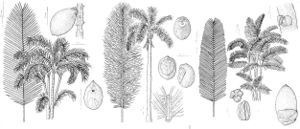Ptychosperma
Memoires de la Classe des Sciences Mathematiques et Physiques de L'Institut National de France 1808(2): 252. 1809.
| Taxon | Illustrator ⠉ | |
|---|---|---|
 | Roystonea regia Dypsis lutescens Ptychosperma macarthurii |
Stems solitary or clustereding, less than 15 cm in diam., unarmed. Leaves: sheath green, unarmed, forming crownshaft; blade pinnate, unarmed; plication reduplicate; segments in 1 plane, usually cuneate, apices jagged and irregular, cleft. Inflorescences axillary below crown of leaves, paniculate, with 2 or 3 orders of branching, pendulous; prophyll short; peduncular bract tubular; secondary peduncular bracts often present, incomplete. Flowers unisexual, sessile, in triads of 1 pistillate flower flanked by 2 staminate flowers. Staminate flowers: sepals 3, imbricate, free; petals 3, valvate, free; stamens [9–] 25–34 [or more], in whorls of 3 or more; pistillode present, with slender style. Pistillate flowers: sepals 3, imbricate, free; petals 3, imbricate, free; staminode lobes or scales present; pistils 1; ovules 1; styles indistinct; stigmas 3. Fruits drupes, small; exocarp red [black], smooth; mesocarp fleshy; endocarp bony, 5-lobed in cross-section [obscurely lobed]. Seeds ovoid; endosperm homogeneous or ruminate; embryo basal; eophyll 2-cleft, segments linear, apices jagged and irregular.
Distribution
Introduced; Fla., Pacific Islands, Australia
Discussion
This genus is popular in cultivation. Two species have sporadically naturalized sporadically in Dade County, Florida. The fruits are red and fleshy, and birds undoubtedly disperse the seeds.
Species 28 (2 in the flora).
Selected References
Lower Taxa
Key
| 1 | Stems solitary | Ptychosperma elegans |
| 1 | Stems clustering | Ptychosperma macarthurii |